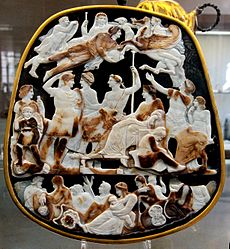
Back Camaféu AST Камея Byelorussian Камея Bulgarian Camafeu Catalan Kamej Czech Kamé Danish Kamee German Kameo Esperanto Camafeo Spanish Kameu Basque



Cameo (/ˈkæmioʊ/) is a method of carving an object such as an engraved gem, item of jewellery or vessel. It nearly always features a raised (positive) relief image; contrast with intaglio, which has a negative image.[1] Originally, and still in discussing historical work, cameo only referred to works where the relief image was of a contrasting colour to the background; this was achieved by carefully carving a piece of material with a flat plane where two contrasting colours met, removing all the first colour except for the image to leave a contrasting background.
A variation of a carved cameo is a cameo incrustation (or sulphide). An artist, usually an engraver, carves a small portrait, then makes a cast from the carving, from which a ceramic type cameo is produced. This is then encased in a glass object, often a paperweight. These are very difficult to make but were popular from the late 18th century through the end of the 19th century. Originating in Bohemia, the finest examples were made by the French glassworks in the early to mid-nineteenth century.[2]
Today the term may be used very loosely for objects with no colour contrast, and other, metaphorical, terms have developed, such as cameo appearance. This derives from another generalized meaning that has developed, the cameo as an image of a head in an oval frame in any medium, such as a photograph.
- ^ Tait, Hugh, ed. (2006). 7000 Years of Jewellery. British Museum Press. p. 216. ISBN 978-0-7141-5032-1.
- ^ Dunlop, Paul H., The Jokelson Collection of Cameo Incrustation, Papier Presse (1991) ISBN 0-9619547-3-6